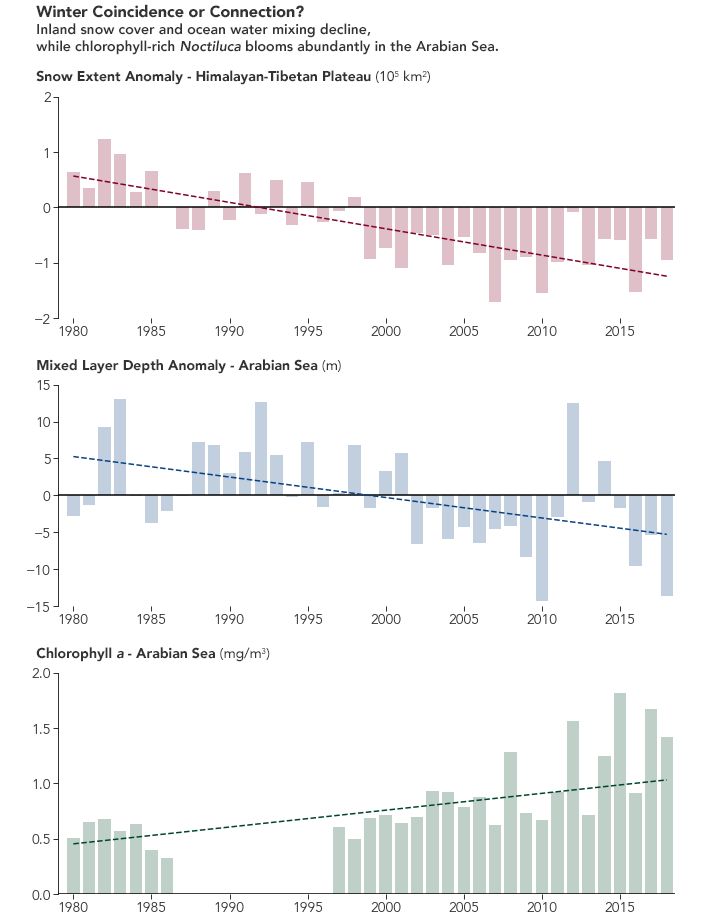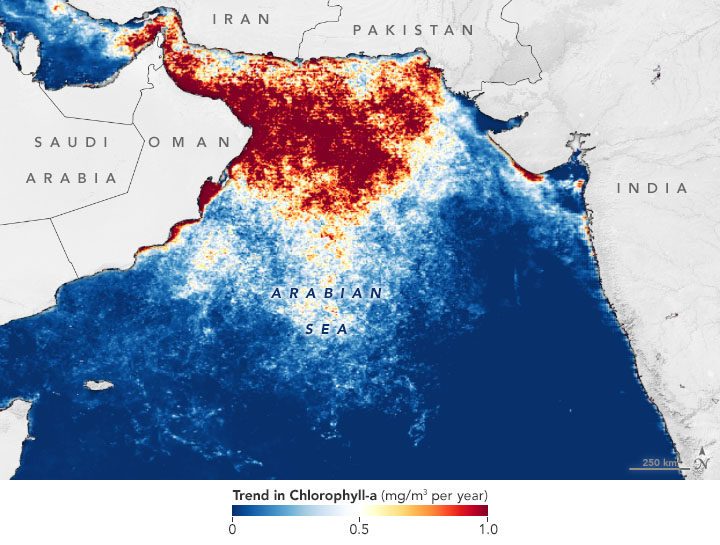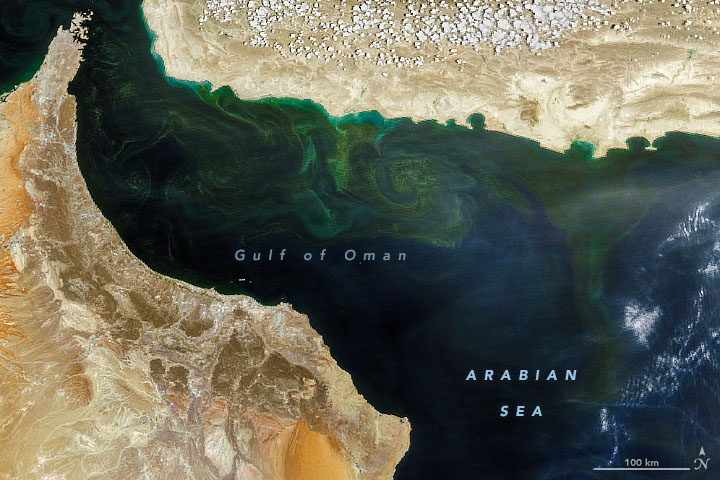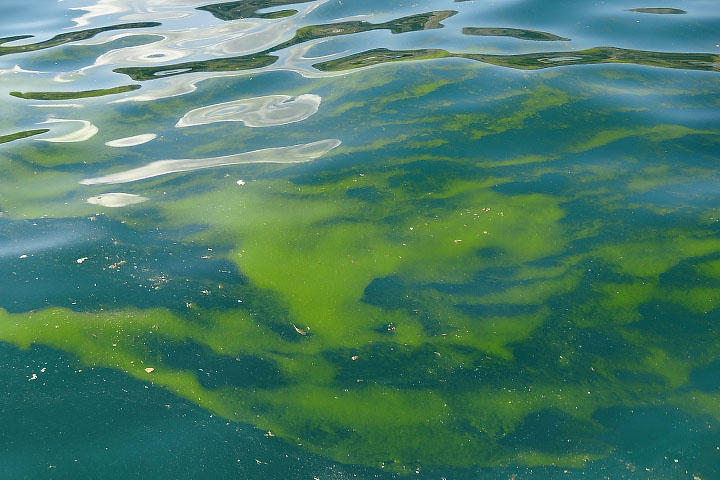Ecosystem in the Arabian Sea
How can the Himalayan snow cover affect the species that thrive in the Arabian Sea? How can changes in wind speed and humidity lead to food and national security a thousand miles away? Joaquim Goes, Helga do Rosario Gomes and colleagues on two continents have been trying to solve these riddles for the past two decades.
The story begins in the early 2000s, around the time of NASA Aqua satellite was triggered. Goes, an expert in ocean remote sensing, researched the data SeaWiFS and Aqua. He focused on chlorophyll-a, a pigment used by ocean phytoplankton (and plants around the world) to harness sunlight and convert it into food energy. He focused on observations of phytoplankton populations in the Arabian Sea during the summer monsoon, but by chance he looked at winter data. There was much more chlorophyll-a than anyone could reasonably expect.
At first, Goes thought it was a mistake. But over the next decade, there were reports from South Asian colleagues of an increase in algae and a decrease in fish catches. Goes and Gomes made several sea voyages and saw it for themselves: the Arabian Sea was full Noctiluca scintillans, an organism that was rarely reported in the area in previous winters.
The image above shows a bloom Noctiluca scintillans in 2019 as detected by the NOAA-NASA Finnish nuclear power plant satellite. Floating, microscopic organisms are dinoflagellates live in symbiotic relationship with green algal cells. Like ocean phytoplankton, Noctiluca scintillans can multiply rapidly under the right conditions. (Noctiluca often thrive on low oxygen “hypoxic“Waters.) As they drift with the currents, they accumulate in large masses near the surface. In the process, they can consume marine oxygen, compete with other phytoplankton for nutrients, or consume them for food and suppress small zooplankton predators in hypoxia.dead areas. ”
“The changes we observe in the Arabian Sea ecosystem are the fastest on the oceans of our planet,” said researcher Goes. Lamont-Doherty Earth Observatory. “The marine habitat is changing and it is short-circuiting the food chain.”
How and why Noctiluca has flourished in the Arabian Sea is a complex story of interconnections Land systems and unexpected vibrations caused by global warming.
Throughout human history, the Arabian Sea has been strongly influenced by monsoon winds, which change direction seasonally and change the direction of sea currents. Last winter, above the Himalayan and Tibetan plains and South Asia, air temperatures would drop significantly and cause dry northeast winds to blow over the Arabian Sea. Cooling of surface waters and changes in density, in turn, would spread by moving through the water column pycnocline– where the density of the water changes due to salinity and / or temperature – up and down. The depth of this ocean layer affects how nutrients well depths and feed on phytoplankton growth.
These winter currents and the availability of nutrients once fed the blooms are hidden, another type of phytoplankton. Lattices were a key link in the ocean food chain, feeding on toothpicks and finfish throughout the winter and ultimately the people who caught these fish.
But with global warming in recent decades, less snow has fallen and accumulated on the Himalayan and Tibetan plains and more snow and ice has melted. Temperatures in the highs and lows have risen, as has humidity. Over the past two decades, the winter winds blowing across the Arabian Sea have become warmer, calmer, and wetter. As a result, the seas change less and there are fewer nutrients for latent and most other phytoplankton.

“The duller and warmer winds and waters reduce ventilation and mixing,” said Helga do Rosario Gomes, a biological ocean researcher, also from Lamont-Doherty. “This leads to more deposition and less nitrate enrichment from below. In some cases, it causes hypoxia.”
These changes have been pretty complete Noctiluca scintillans. Unlike latent, Noctiluca can thrive when there are less dissolved nutrients in the water. The above diagrams show simultaneous changes in the extent of snow cover in the Himalayan-Tibetan plain, in the depth of the Arabian Sea mixed layer in winter, and in the concentration of chlorophyll-a (phytoplankton indicator). . The “anomaly” curves show how much each year was above or below the long-term average of each variable. The extent of snow and the depth of the mixed layer have steadily decreased, while winter inflorescences have increased.
“The changes observed in the Arabian Sea are an example of the potential ecosystem changes caused by climate change,” said Laura Lorenzoni, a researcher in NASA’s marine biology and biogeochemistry program. “As the Earth warms, we can expect greater ocean stratification and species migration toward the pole. There is also a greater chance that harmful algal blooms and some more sustainable species will compete with each other and change the structure of the whole ecosystem. “
Scientists have modeled and speculated for years that global warming could change the snow and ice cover of the Himalayan and Tibetan plains and that the effects could spread across the sea. It was believed that productivity in the Arabian Sea would decline from December to March. Instead, it has become more productive, but for a completely different set of creatures.

“There are far fewer latentities now, so biodiversity is clearly declining,” Gomes said. “In the past, there were more cephalopods, sardines, kingfish, mackerel and pelagic fish. ” Plankton and latent have been replaced by carpets Noctiluca scintillans and an excess of jellyfish and marshes. Fish have been replaced by turtles, squid, and animals that can survive at lower oxygen levels.
In the 2020 research paper, Goes and Gomes used NASA’s ocean color data as well as National Snow and Ice Data Center snow and ice cover data to assemble the puzzle. They found that winter chlorophyll-a in the Arabian Sea has increased steadily since the 1990s – up to four times more in some winters. Chlorophyll-a is a key pigment in ocean phytoplankton, including Noctiluca scintillans. The map above shows a trend – mostly increasing – in the Arabian Sea between 1996 and 2018.
The result is difficulties for fishing, especially in an area with a lot of small-scale and self-sufficient fishing. “We’re passing a turning point,” Goes said. “The food chain has been turned upside down.”
The changes are causing problems for residents of the Middle East, East Africa and South Asia. An estimated 150 million people around the region are dependent on fishing for food and economic development. Yet the surplus of jellyfish and lizards and the reduction of lice have reduced the nutrition of edible fish. ”
“There are successive impacts that are likely to affect food availability in several countries in the region,” Goes said. “Noctiluca inflorescences, jellyfish and lizards also pose huge challenges for coastal desalination plants that supply fresh water to the coast of Oman. ”Jellyfish are known to clog seawater intake pipes.
And a change to that Noctiluca-huge waters have an unusual ripple effect on national security. Noctiluca scintillans are bioluminescent: they glow when stimulated and this is especially evident at night. This feature can be used monitor ship movements who mix plankton during their cruise. Sailors and pilots have been followed such glittering traces for decades.
“There are many examples of phytoplankton running around the planet,” said Norman Kuring, a NASA researcher. Ocean Biology Group. “There is a new summer flowering normal for toxic blue-green algae in the Baltic Sea. Green algae regularly clog the waters of China’s Shandong Peninsula. Sargassum is becoming a real headache in the Caribbean. Lakes in the United States and globally are constantly eutrophic. Distinguished scientists have made worrying suggestions that our oceans may be on their way to a hypoxic, bacteria-dominated future.
NASA Earth Observatory map and chart prepared by Joshua Stevens, using data Goes, J. et al. (2020). NASA image of Norman Kuring /NASA’s Ocean Color Web, using VIIRS information Finland’s national polar partnership. Photo: Joaquim Goes. The story of Michael Carlowicz.





